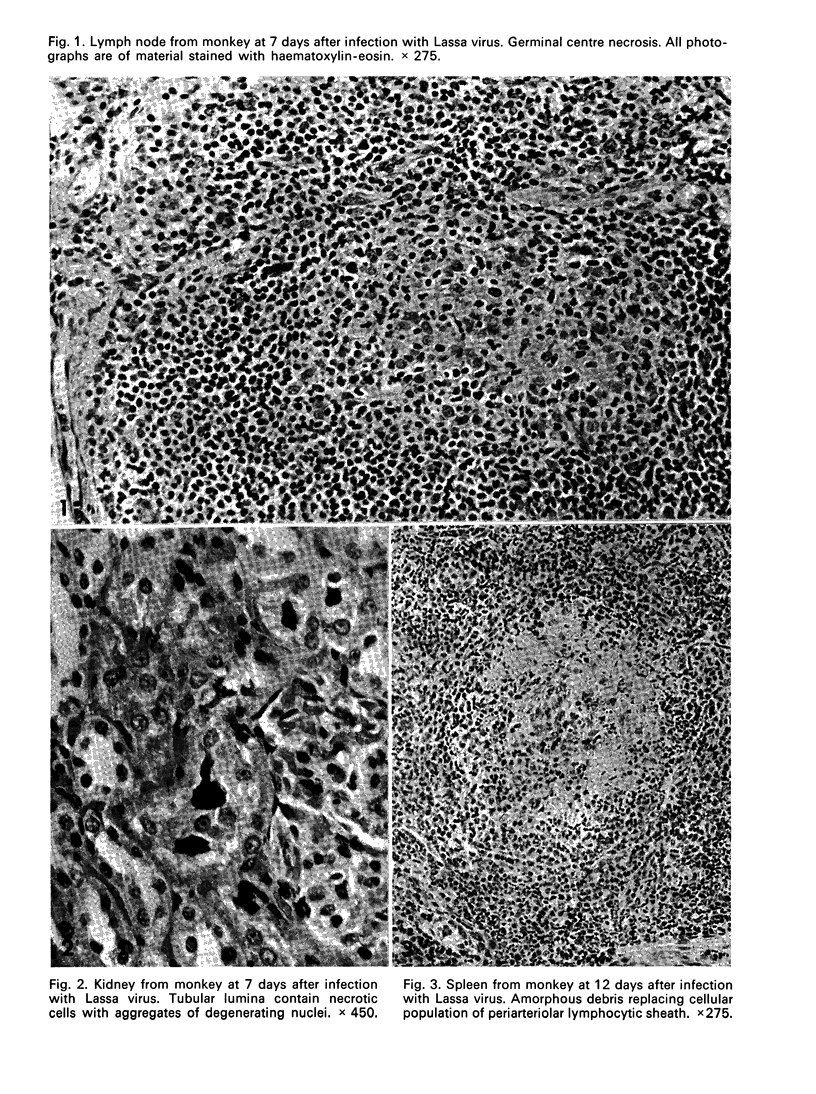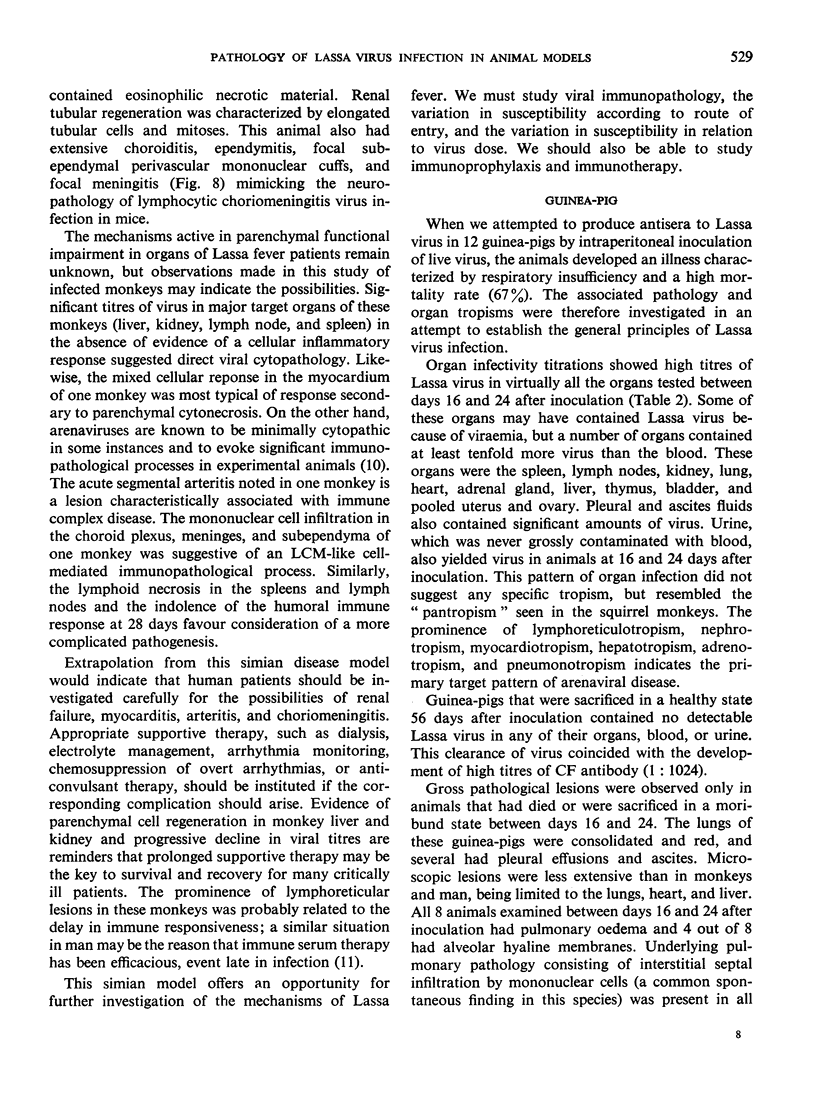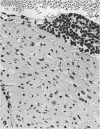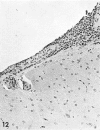Abstract
Experimental Lassa virus infections of squirrel monkeys, guinea-pigs, and the African multimammate rat, Mastomys natalensis, were studied virologically and pathologically. In the monkeys, early viral lymphoreticulotropism, hepatotropism, nephrotropism, and viraemia were noted. At the time of death, viral titres in nearly all target organs were associated with necrotic changes: splenic lymphoid necrosis, renal tubular necrosis, myocarditis, arteritis, and hepatocytic regeneration. In convalescent monkeys, organ titres diminished slowly, and viraemia persisted at 28 days. At this time, renal and splenic regeneration was occurring and a new lesion, choriomeningitis, was present.
Guinea-pigs infected with Lassa virus developed respiratory insufficiency with pulmonary oedema, alveolar hyaline membranes, myocarditis, and focal calcification of myocardial fibres and hepatocytes. Dying animals contained Lassa virus in virtually every organ tested, whereas survivors at 56 days were free of virus and had high complement-fixing antibody titres.
Infection of neonatal Mastomys did not cause any clinical disease or pathological lesions despite the presence of virus in the blood, lymph nodes, liver, spleen, lung, brain, urine, and throat secretions throughout the 74-day study. Infected adult Mastomys also remained normal but had virus in many organs. In one animal, virus persisted until the termination of the study at 103 days. Several animals developed a mild meningoencephalitis. The pattern of infection and virus shedding in M. natalensis is ideal for maintenance of the virus in nature; together with the epidemiological field data this emphasizes the incidental nature of the exposure and infection of man.
Full text
PDF











Images in this article
Selected References
These references are in PubMed. This may not be the complete list of references from this article.
- Buckley S. M., Casals J. Lassa fever, a new virus disease of man from West Africa. 3. Isolation and characterization of the virus. Am J Trop Med Hyg. 1970 Jul;19(4):680–691. doi: 10.4269/ajtmh.1970.19.680. [DOI] [PubMed] [Google Scholar]
- Cole G. A., Nathanson N. Lymphocytic choriomeningitis. Pathogenesis. Prog Med Virol. 1974;18(0):94–110. [PubMed] [Google Scholar]
- Edington G. M., White H. A. The pathology of Lassa fever. Trans R Soc Trop Med Hyg. 1972;66(3):381–389. doi: 10.1016/0035-9203(72)90268-4. [DOI] [PubMed] [Google Scholar]
- Henderson B. E., Gary G. W., Jr, Kissling R. E., Frame J. D., Carey D. E. Lassa fever. Virological and serological studies. Trans R Soc Trop Med Hyg. 1972;66(3):409–416. doi: 10.1016/0035-9203(72)90272-6. [DOI] [PubMed] [Google Scholar]
- Justines G., Johnson K. M. Immune tolerance in Calomys callosus infected with Machupo virus. Nature. 1969 Jun 14;222(5198):1090–1091. doi: 10.1038/2221090a0. [DOI] [PubMed] [Google Scholar]
- Leifer E., Gocke D. J., Bourne H. Lassa fever, a new virus disease of man from West Africa. II. Report of a laboratory-acquired infection treated with plasma from a person recently recovered from the disease. Am J Trop Med Hyg. 1970 Jul;19(4):677–679. doi: 10.4269/ajtmh.1970.19.677. [DOI] [PubMed] [Google Scholar]
- Monath T. P., Newhouse V. F., Kemp G. E., Setzer H. W., Cacciapuoti A. Lassa virus isolation from Mastomys natalensis rodents during an epidemic in Sierra Leone. Science. 1974 Jul 19;185(4147):263–265. doi: 10.1126/science.185.4147.263. [DOI] [PubMed] [Google Scholar]
- Reynolds E. S. Liver parenchymal cell injury. 3. The nature of calcium--associated electron-opaque masses in rat liver mitochondria following poisoning with carbon tetrachloride. J Cell Biol. 1965 Jun;25(3 Suppl):53–75. doi: 10.1083/jcb.25.3.53. [DOI] [PMC free article] [PubMed] [Google Scholar]
- Terrell T. G., Stookey J. L., Eddy G. A., Kastello M. D. Pathology of Bolivian hemorrhagic fever in the rhesus monkey. Am J Pathol. 1973 Nov;73(2):477–494. [PMC free article] [PubMed] [Google Scholar]
- Walker D. H., Wulff H., Murphy F. A. Experimental Lassa virus infection in the squirrel monkey. Am J Pathol. 1975 Aug;80(2):261–278. [PMC free article] [PubMed] [Google Scholar]
- Winn W. C., Jr, Monath T. P., Murphy F. A., Whitfield S. G. Lassa virus hepatitis. Observations on a fatal case from the 1972 Sierra Leone epidemic. Arch Pathol. 1975 Nov;99(11):599–604. [PubMed] [Google Scholar]
- Winn W. C., Jr, Walker D. H. The pathology of human Lassa fever. Bull World Health Organ. 1975;52(4-6):535–545. [PMC free article] [PubMed] [Google Scholar]














